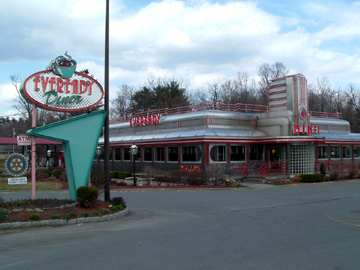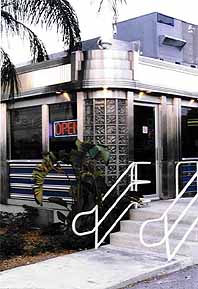The Story of Roadside Fan #5501
Part two: They have books about this?
It was a weekday evening in the summer of 1994, and Susan and I just wanted to relax and watch something on TV. Since this was summer, the offerings on many of the networks were pretty slim. Then I noticed that the PBS station had a program with an intriguing title:
“Pennsylvania Diners and Other Roadside Restaurants.”
We decided, “Why not?”
At that time, I was hardly a diner expert. Being a native Northeasterner, I certainly remembered diners from my youth, and knew that there were still diners around today, many of them large, brightly lighted places with gigantic menus. But at the time I could not have named a single diner manufacturer.

Pennsylvania Diners was one of several programs with roadside-related themes that Rick Sebak produced for WQED Pittsburgh. Years later, at Diner-Rama 2001, I would visit several of the diners appearing in the program.
“Pennsylvania Diners” was a quick immersion into diner culture. Right at the start, they showed us the wonderfully preserved Wellsboro Diner, told us that it was a Sterling, and the camera panned across the tag. The reason for this became apparent during the second diner visit in the program, to the Sunrise Diner in Jim Thorpe, an O’Mahony. Narrator Rick Sebak noted, “Serious diner buffs always like to know which company manufactured the diner.”
The program then proceeded to tell a little diner history and went on to visit more than two dozen diners of the Keystone State. There was fascinating archival material, including home movie footage of Serro’s Diner, a 1957 Mountain View, being towed up the Lincoln Highway. You could see the Ship Hotel reflected in the diner’s large plate glass windows as it went by. The program also visited some fascinating roadside places that were not diners, such as Potato City Motor Inn and the Midway travel plaza on the Pennsylvania Turnpike. At the latter, they took us through the tunnel under the highway and talked about the restaurant’s glory days as a Howard Johnson’s.
The program also contained several reminders of why I did not always like diner food. We learned that the apple pies at the Melrose Diner are made with canned apples, pie crusts at the Venus Diner are made with pure lard, and if they burn your toast at the Smethport Diner, the waitress is skilled at hiding the damage. We also saw dozens of hamburgers swimming in puddles of grease on flat grills at more diners than I could count. (Nothing compares to char-grilled burgers, in my view.) But the most indigestion-inducing creation of all was the “Texas Tommy” at the Cup in Pottstown – a hot dog sliced lengthwise, stuffed with cheese, wrapped in bacon, and deep fried!
Susan had become accustomed to me falling asleep during TV movies and such. This time, she noticed that I stayed awake until the very end, hanging on every detail.

When I first received this book, I thought it was a very nice book about diners. Later, I would learn that enthusiasts regarded it as THE book about diners.
For Christmas that year, Susan came up with an idea for a very special present: she wanted to get me a book about diners. Not having any idea what to get (and searching on Amazon was still off in the future for us) she went to the local “big box” bookstore. When she asked the salesperson to recommend “a book on diners,” the response was, “My friend’s father owns the Miss Albany Diner and he says this is the one to get.”
That Christmas morning, I unwrapped my very own copy of American Diner Then and Now by Richard J. S. Gutman.
Here in one book was all kinds of fascinating details about diners that I never knew before. There was history going all the way back to Walter Scott’s lunch wagon, details about diner manufacturers, tags, Sterling Streamliners, Fodero winged clocks, Mountain View cowcatchers, and Paramount wedding cake corners. There were beautiful photographs, including diners I had seen such as Jack’s in Albany. Finally, there was a directory, “Where the Diners Are,” where I could look up the manufacturers of all the diners I knew about and be reminded of others about which I had forgotten. There was but one problem with this neat little book: it had an end.
Next, I wanted to see if there were other books like American Diner Then and Now. I soon found that “roadside” is not a standard bookstore category such as fiction or philosophy or health. It overlaps travel, transportation, architecture, and pop culture. Often I would just look for where the bookstore shelved American Diner Then and Now and see what other books were on the shelf next to it. Happily, I was able to find several good ones. I started acquiring and reading books about a variety of roadside topics: gasoline stations, motels, Route 66 and such.
One book that influenced me greatly was Main Street to Miracle Mile by Chester Liebs. There is probably no other single book that I have found that does such a good job of analyzing the various types of roadside architecture throughout the automobile age.
All of a sudden, any trip to anywhere took on a new dimension. I would seek out vintage diners and other classic roadside structures and photograph them.The books I had read offered plenty of good clues as to where I could find such buildings, and my childhood memories from all those car trips years earlier were certainly a help. I started looking for diner tags or other clues to identify the manufacturer. Sometimes I would ask the waitress questions about a diner, and learned that this was a hit or miss proposition. Sometimes I would get an enthusiastic “Oh, yes, this is a Mountain View“, but just as likely I would get blank stares and offhanded “who cares?” style answers.

The owner of this diner asked me, “You want to buy my diner?” I declined the offer.
In the summer of 1995 we were on the road in Hyde Park, New York and stumbled upon the as-yet-unopened Eveready Diner. This diner was quite a sight, very large and also very flashy in the retro-1950s style that would become increasingly popular in the coming years. We stopped and walked around and peeked in the windows when all of a sudden a Cadillac pulled into the lot. A gentleman emerged from the car and asked me, “You want to buy my diner?” We then talked about the diner for a while, and I was able to find out that the diner was a Paramount.

I brake for diners: Paramount’s superb wedding cake corner caught my eye on busy US Route 1.
The following summer, we were driving on US Route 1 near Miami, Florida when we spotted a sight unusual for Florida: a large 1950s style stainless steel diner. I became even more excited when I caught a fleeting glimpse of the diner corner: tiers made of stainless steel such as you would find on a wedding cake topped off by a shiny silver ball, just like the picture in American Diner Then and Now. Right away, I knew, “It’s a Paramount!” Susan probably wishes that I were a little more attentive to my driving at this moment, and we joked that a bumper sticker reading “I Brake for Diners” would be a good idea. (The diner is the Gourmet Diner, a 1994 replica by Paramount of their noteworthy corner detail from 1950.)
Our family made compromises in order to keep my fascination under control. I promised not to drive Susan and Ray a half hour out of our way just to get to a diner, but if we went directly past one, I got to stop and take a picture. Of course, the fact that I was the primary route planner had its advantages. A couple of years later, on a trip built around college visits, I was happily able to include part of the Lincoln Highway on our travel route.
In 1996, I installed a modem in our computer and we began surfing the Internet, becoming part of a trend that was sweeping the nation. As with most novice surfers, we were overwhelmed with the sheer volume of material on the World Wide Web, and soon began using that indispensable tool, the search engine. With the likes of Yahoo or Alta Vista, you could discover web sites of interest just by entering a word or group of words.
So, one day I decided to try the word “DINER” just to see what would happen. I discovered that there was a lot more roadside information online than I had imagined.
Thus began a habit, which continues to this day, of spending an hour or so online when I first get up in the morning. I would visit sites such as Dave’s Diner Homepage or Chrone’s Virtual Diner. Often they had pictures (which took a long time to load with a dial-up modem), diner reviews, and, best of all, links to even more sites. This filled many fascinating hours, but eventually I would discover something: that once I had read everything on a particular web site, there was little reason to go back. Many of the sites were updated infrequently, if at all. On the other hand, I had developed a thirst for new roadside knowledge that I sought to quench.
Then, I discovered one web site that stood out from all the others. That was the web site for something called Roadside Magazine.
